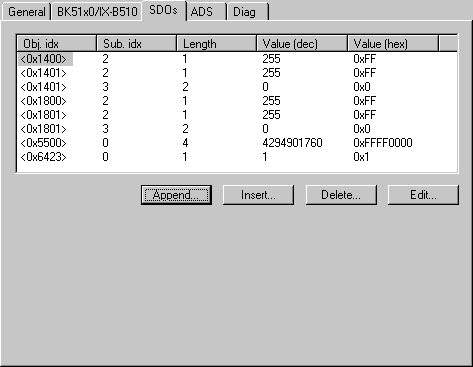BK51x0/LC5100/IPxxxx-B510 (CANopen)
The BK51x0 Bus Coupler and the IPxxx-B510 fieldbus box are installed in the CANopen bus. Those specific properties which distinguish them from other Bus Couplers and/or Fieldbus Box modules are described below. For an Overview of currently supported CANopen Bus Couplers BK51x0, see...
"BK51x0/IX-B510" tab

Node Id: Sets the node ID of the CAN bus device (between 1 and 63 (BK51x0) and/or 1 and 99 (IPxxxx-B510)). This value must comply with the value set at the Bus Coupler and/or at the compact box.
Guard time: Cycle time for the node monitoring (node guarding).
Life time factor: Guard time multiplied produces the watchdog time for the monitoring of the master by the coupler (life guarding). Life guarding is deactivated if the lifetime factor is set to zero.
Inhibit time: Displays the minimum send interval for PDOs (telegrams) with analogue and special signals. If more than digital 64 signals are present, these are also provided with this Inhibit Time.
Event Time: Sets the Event Timer Value for Transmit PDOs. The expiration of this timer is regarded as additional event for the corresponding PDO. Thus, the PDO is being sent. If the application event occurs during the event timer period, the PDO is sent as well, and the timer is reset.
K-Bus Update: Calculates the anticipated duration of a complete update of the terminal bus (according to type and number of connected terminals).
Trans.Type: Gives the Transmission Type for digital / analogue input telegrams. 254 + 255 corresponds to the event-driven transfer, 1 … 240 are synchronous transfer types. For further details see also BK51X0 manual.
Firmware Update: Enables the updating of the coupler firmware via the serial interface (requires KS2000 software package interface cable).
Input Diagnosis
FC510x: Each CANopen fieldbus box node contains one diagnostic input byte (Node State), which signals the status of the current slave during the running time and can be linked, for example with the PLC. In addition a signal is sent via the "Diag Flag" bit informing as to whether the card contains new Diagnostic Information. This can then be read off using ADS READ.
CIF30-CAN: Each CANopen fieldbus box node contains one diagnostic input byte (Box State), which signals the status of the current slave during the running time and can be linked, for example with the PLC. In addition there is a further bit ”DataExchange", which indicates whether the node is exchanging data.
”SDOs” tab

SDO inputs sent to the node at StartUp are displayed/managed on this page. Inputs with an object index in straight brackets are automatically created based on the updated terminal configuration. Other inputs can be managed using ”Add”, ”Insert”, ”Delete” and ”Edit”.
”ADS” tab
In order to be able to read and write SDO objects during the running time (e.g. from the PLC), the node (Bus Coupler) can be allocated an ADS port (CIFx0-CAN). The FC510x always provides an ADS port for every node since the diagnostic information is transported via ADS. These ports can be used to read and write SDO objects using ADS read requests and/or write requests.
The ADS IndexGroup contains the CANopen object index and the ADS IndexOffset contains the CANopen SubIndex.
CANopen Emergency Object
Some CANopen status data and emergency objects received from a node can be read by any TwinCAT program via ADS and/or signalled to any TwinCAT program. The data structures and addresses distinguish between the FC510x and the CIFx0-CAN.